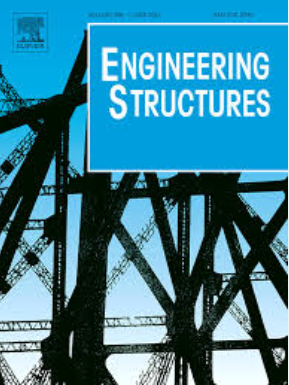FRP约束矩形高强钢管混凝土柱偏心受压性能的数值研究及设计建议
IF 6.4
1区 工程技术
Q1 ENGINEERING, CIVIL
引用次数: 0
摘要
本文对纤维增强聚合物(FRP)约束矩形高强钢管混凝土(CFST)柱偏心受压性能进行了数值研究。建立了FRP约束CFST (FRP-CFST)柱的精细化有限元模型,并根据试验结果进行了验证,包括破坏模式和荷载-位移关系。进一步进行参数分析,考察钢材屈服强度、混凝土强度、转角半径、宽厚比、FRP层数、部分包覆方案、偏心距、FRP取向对偏心抗压性能和FRP改善效果的影响。结果表明,增加FRP层数是提高承载力和延性的有效途径。较大的转角半径可减小应力集中,提高约束效率,但转角半径与宽度之比应小于1/6,以避免承载区域损失。可采用间距适当的FRP条降低成本,但缠绕比例不应低于1/3,以保证足够的约束效果。偏心距小时,横向FRP加固效果较好,偏心距越大,纵向FRP加固效果越明显。因此,偏心比大于2时,建议采用横向和纵向FRP复合方案。提出并验证了两种N-M相互作用模型对偏心承载力的预测,其中塑性应力分布模型预测更为准确。研究结果可为实际工程应用中FRP-CFST柱的设计提供有价值的建议。本文章由计算机程序翻译,如有差异,请以英文原文为准。
Numerical study and design recommendation on eccentric compression behavior of FRP confined rectangular high-strength concrete-filled steel tubular columns
This paper presents a numerical study on the eccentric compression behavior of fiber reinforced polymer (FRP) confined rectangular high-strength concrete-filled steel tubular (CFST) columns. A refined finite element (FE) model of FRP confined CFST (FRP-CFST) column was developed and validated against the experimental results, including failure modes and load-displacement relationships. A parametric analysis was further conducted to investigate the influence of steel yield strength, concrete strength, corner radius, width-to-thickness ratio, number of FRP layers, partial wrapping scheme, eccentricity and FRP orientation on the eccentric compression performance and FRP improvement effect. The results indicate that increasing the number of FRP layers is an effective way to enhance the bearing capacity and ductility. A larger corner radius contributes to greater confinement efficiency by reducing stress concentration, but the corner radius-to-width ratio should be less than 1/6 to avoid the loss in bearing area. Appropriately spaced FRP strips can be utilized to reduce costs, but the wrapping proportion should not fall below 1/3 to ensure sufficient confinement effectiveness. Transverse FRP is more effective under small eccentricity, while longitudinal FRP improvement becomes dominant as eccentricity increases. Therefore, a hybrid scheme combining transverse and longitudinal FRP is recommended for eccentricity ratio greater than 2. Furthermore, two N-M interaction models were proposed and verified to predict the eccentric bearing capacity, with the plastic stress distribution model yielding more accurate predictions. The findings can provide valuable design recommendations for FRP-CFST columns in practical engineering applications.
求助全文
通过发布文献求助,成功后即可免费获取论文全文。
去求助
来源期刊

Engineering Structures
工程技术-工程:土木
CiteScore
10.20
自引率
14.50%
发文量
1385
审稿时长
67 days
期刊介绍:
Engineering Structures provides a forum for a broad blend of scientific and technical papers to reflect the evolving needs of the structural engineering and structural mechanics communities. Particularly welcome are contributions dealing with applications of structural engineering and mechanics principles in all areas of technology. The journal aspires to a broad and integrated coverage of the effects of dynamic loadings and of the modelling techniques whereby the structural response to these loadings may be computed.
The scope of Engineering Structures encompasses, but is not restricted to, the following areas: infrastructure engineering; earthquake engineering; structure-fluid-soil interaction; wind engineering; fire engineering; blast engineering; structural reliability/stability; life assessment/integrity; structural health monitoring; multi-hazard engineering; structural dynamics; optimization; expert systems; experimental modelling; performance-based design; multiscale analysis; value engineering.
Topics of interest include: tall buildings; innovative structures; environmentally responsive structures; bridges; stadiums; commercial and public buildings; transmission towers; television and telecommunication masts; foldable structures; cooling towers; plates and shells; suspension structures; protective structures; smart structures; nuclear reactors; dams; pressure vessels; pipelines; tunnels.
Engineering Structures also publishes review articles, short communications and discussions, book reviews, and a diary on international events related to any aspect of structural engineering.
 求助内容:
求助内容: 应助结果提醒方式:
应助结果提醒方式:


